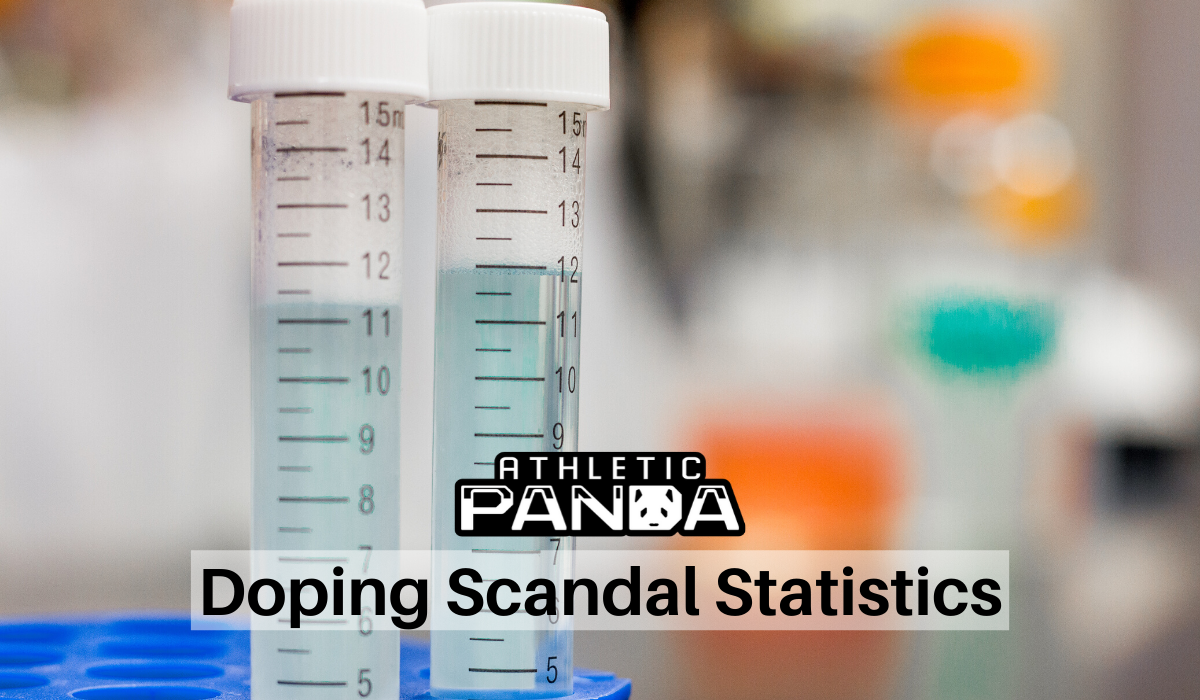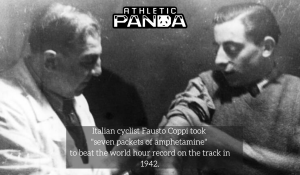Doping in sports is a tale as old as time. It has been synonymous with sports from the very beginning, dating all the way back to the creation of sports itself.
Let’s race down memory lane to look up some doping scandal statistics and see how the World Anti-Doping Agency is working towards fighting the ever-present abuse of performance-enhancing drugs.
Ultimate Doping Scandal Statistics:
- Overall number of samples analyzed – 344,177 in 2018
- Number of adverse analytical findings – 4,896 in 2018
- Number of confirmed anti-doping rule violations – 1,804 in 2017
- Number of substances on the WADA prohibited list – 243
- Sport with the most anti-doping violations – Bodybuilding, 266
- Country with the most anti-doping violations – Italy, 171
- Most Olympic medals stripped for doping violations – Russia, 43 medals
1. Performance-enhancing drugs in the Olympics date back to 1904
(Source: sports-reference)
- Thomas Hicks won the Olympic marathon in 1904 with the use of strychnine and brandy.
- The use of strychnine, at the time, was thought necessary to survive demanding races.
- At the 1960 Olympic Games in Rome, Danish rider Knud Enemark Jensen became the only Olympic athlete to die from athletic drug-use.
- Anti-doping and testing procedures only began at the 1968 Summer Olympics in Mexico City.
- Hans-Gunnar Liljenwall was the first Olympic athlete to test positive for the use of performance-enhancing drugs.
Olympic doping goes all the way back to the inception of the games in ancient Greece. Athletes were known to drink “magic potions” and eat exotic meats in the hopes of getting an edge over their competition.
Over time performance-enhancing drugs in sports in general and in the Olympics, in particular, became a more sophisticated science and the use of strychnine, a pesticide used for killing small vermin, became widely used. Next came boosting testosterone and it wasn’t until the mid-1960s that sports federations all over the world started banning PEDs.
There are conspiracy theories about widespread doping programs in East Germany and Russia throughout the 70s and 80s. No clear evidence was found until much later when the Olympic Committee couldn’t penalize those responsible.
2. Benzedrine first appeared in sports at the Berlin Olympics in 1936
(Source: workers.org)
- It was produced in 1887 and was isolated in the U.S. in 1934 by Gordon Alles.
- German athletes were given amphetamine injections in the 1936 Olympics.
- Everton were champions of the English Premier League during the 1962–63 season with the help of Benzedrine.
- Italian cyclist Fausto Coppi took “seven packets of amphetamine” to beat the world hour record on the track in 1942.
Benzedrine is the trade name for amphetamine, a stimulant used in the treatment of ADHD. According to the European Council, it first appeared in sports during the Berlin Olympics in 1936 and was also used by the British troops during the Second World War.
Amphetamines weren’t illegal at the time so they were used for an assortment of things, from aiding in weight-loss to serving as antidepressants.
They soon became recreational drugs and were given the street name “speed” Former Everton goalkeeper Albert Dunlop admitted to being an addict when the drugs were freely distributed in the Everton locker room during their championship-winning season.
3. John Ziegler created the first oral anabolic steroid, methandrostenolone, in 1958
(Source: Slate)
- Ziegler was the physician for the US weightlifting team in the mid-20th century and helped steroids spread to other sports.
- Paul Lowe admitted that in 1970, NFL team the San Diego Chargers were given steroids at lunch.
- Olympic statistics show the weight of shot putters increased by 14% between 1956 and 1972.
According to steroids statistics and facts, anabolic steroids were first identified and synthesized in the 1930s but weren’t used for physical enhancement in sports until John Ziegler’s trip to Vienna with the US weightlifting team. The results were so impressive that lifters started taking more, and the substances spread to other sports.
Gold medalist pentathlete Mary Peters said that a medical research team was set up in the US at some point in an attempt to gather research into the use of steroids by lifters and throwers, only to discover that so few weren’t taking them that they couldn’t establish a worthwhile comparison.
The most prominent doping scandal involving anabolic steroids was at the 1988 Summer Olympics in Seoul where Canadian runner Ben Johnson won the men’s 100m race in record time but then subsequently failed the steroids testing when ‘stanozolol’ was found in his urine.
Carl Lewis was then given the Olympic gold title and the world record but it was later revealed that Lewis was the beneficiary of a large-scale doping cover-up by the United States Olympic Committee.
4. EPO is believed to have been widely used by athletes in the 1990s
(Source: The Star)
- Erythropoietin (EPO) is largely taken by endurance sports athletes such as swimmers, long-distance runners, cyclists, rowers, and cross-country skiers.
- EPO was at the center of the “Festina Affair” from the 1998 Tour de France.
- In 2005, Lance Armstrong was stripped of his Tour de France titles due to his use of EPO since 1998.
- 2006 Tour de France winner Floyd Landis tested positive, twice, for banned synthetic testosterone.
- 2004 Hawaii Ironman triathlon winner Nina Kraft was disqualified for a positive EPO test.
EPO and the infamous “pot Belge”, a mixture of various drugs including cocaine, heroin, caffeine, amphetamines, and other analgesics, has a long history in the professional cycling world.
In 1998, the entire Festina cycling team was excluded from the Tour de France following the discovery of a team car containing large amounts of various performance-enhancing drugs, including EPO.
Other athletes caught doping at the time include 2003 World-Time Trial Champion David Millar, 2005 Vuelta an España winner Roberto Heras and 2006 Tour de France winner Floyd Landis — all tested positive for EPO, with the biggest culprit being seven-time Tour de France winner Lance Armstrong.
5. The World Anti-Doping Agency was founded in 1999 to combat doping in sports
(Source: WADA)
- The body was established by the International Olympic Committee after the 1998 doping scandal in cycling.
- WADA does doping tests for all international sporting codes.
- They determine the banned performance-enhancing drugs list.
- WADA conducted a survey that revealed that 44% of athletes taking part in the 2011 World Championships in Athletics admitted to using banned substances.
- Only 0.5% of those tested were caught.
WADA is a foundation initiated by the IOC to “promote, coordinate and monitor the fight against drugs in sports”. The body also established the World Anti-Doping Code, which covers substances and methods that sportspersons are not allowed to take or use.
In 2016, Professor Richard McLaren, an independent investigator working on behalf of WADA published a damning document that would later be known as the “McLaren Report”. It detailed how more than 1,000 Russians athletes in over 30 sports were involved in or benefited from state-sponsored doping between 2011 and 2015.
In the same year, WADA revealed that their systems had been hacked, and many analysts believe it was in retaliation against the report. The hack published, among other things, the Olympic drug-testing files of several athletes and the personal information of Russian runner Yuliya Stepanova, who helped blow the whistle on the whole scandal.
6. In 2019, WADA banned Russia from major international sporting events for four years
(Source: NYTimes)
- The decision was made following a three-year-long stalemate between WADA and Russia after Professor McLaren’s two-part report in 2016.
- Russia was barred from hosting, participating in, or establishing bids for international sporting events.
- A number of Russian officials were also suspended.
- WADA will allow Russian athletes cleared of the doping scandal to compete neutrally, but not under the Russian flag.
Documents obtained in 2016 revealed a statewide Russian doping program in preparation for the 1984 Summer Olympics. The previous Olympics in Moscow were dubbed the “Chemists’ Games” by an Australian study that alleged there was hardly a medal winner who wasn’t on some kind of drug.
Following the release of the McLaren Report, WADA recommended that the IOC ban Russia from competing in the 2016 Olympics but they rejected it and decided that individual sanction decisions would be made by each sport federation.
Despite widely accepted evidence, the Russian Olympic ban was lifted in 2018 by the IOC, a decision met with mass criticism. it was widely reported that some of the data retrieved from the Moscow laboratory may have been manipulated and tampered with before it was retrieved by the World Anti-Doping Agency.
7. There were 1,804 confirmed doping violations from 322,050 samples tested in 2017
(Source: WADA)
- The samples were collected from competitors from 93 disciplines and 114 nationalities.
- Of the offenders, 1,776 were athletes and 28 were athlete support personnel.
- Bodybuilders made up the largest percentage of offenders, followed by athletics and cycling.
- Italy and France were the top nationalities of violators.
The 2017 Anti-Doping Rule Violations’ (ADRVs’) Report spotlights doping offenses committed in global sport during 2017.
A total of 1,804 doping violations were recorded that year, marking about a 13.1% increase relative to the 2016 figure of 1,595.
1,459 of the violations came out of adverse analytical findings (AAFs), commonly known as ‘positive’ results. The remainder were derived from investigations and evidence-based intelligence into 317 violations committed by athletes and 28 by athlete support personnel.
8. The number of overall samples analyzed by WADA increased by 6.9% from 2017 to 2018
(Source: WADA)
- 60% of WADA-accredited laboratories saw an increase in the total number of samples recorded.
- Samples increased from 322,050 in 2017 to 344,177 in 2018.
- GH testing increased by 18% between 2017 and 2018.
WADA publishes an annual report which summarizes the results of all the samples WADA-accredited Laboratories analyzed and reported in WADA’s Anti-Doping Administration and Management System (ADAMS) in 2018.
This information is valuable to anti-doping organizations that can use it to adapt their strategies and better target-test their athletes, helping protect clean athletes, maintaining the integrity of sport and generating fewer doping scandal statistics.
FAQs
Q: What PEDs are banned in the NFL?
A: All performance-enhancing drugs are banned by virtually every sporting body, in the NFL the most prominent PEDs are anabolic steroids.
Q: Are Russian athletes still banned?
A: Yes, they are. The World Anti-Doping Agency has banned Russia from all major sporting events until 2023.
Q: Do Olympic athletes get drug tested?
A: Yes, they do. The number of tests conducted during the Olympic Games has increased over the years, Olympic athletes can be tested at any time — potentially even years in advance of the next competition.
Q: What percentage of athletes use performance-enhancing drugs?
A: The latest report from the World Anti-Doping Agency shows 1,804 confirmed Anti-Doping Rule Violations (ADRVs) from 322,050 samples tested in 2017.
Q: What athletes have taken drugs?
A: Cyclist Lance Armstrong, cricketer Shane Warne, football legend Diego Maradona, and track & field star Marion Jones are just a few of the most high profile athletes that have used PEDs, according to doping scandal statistics.
Sources:
1. Sports-reference
2. Workers.org
3. Slate
4. The Star
5. WADA
6. NYTimes
7. WADA
8. WADA

